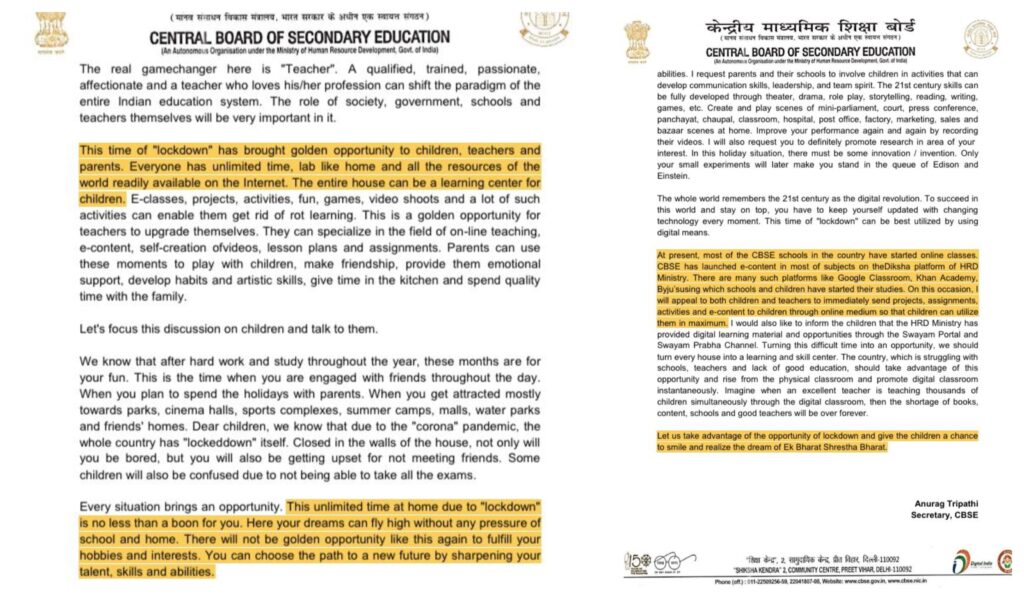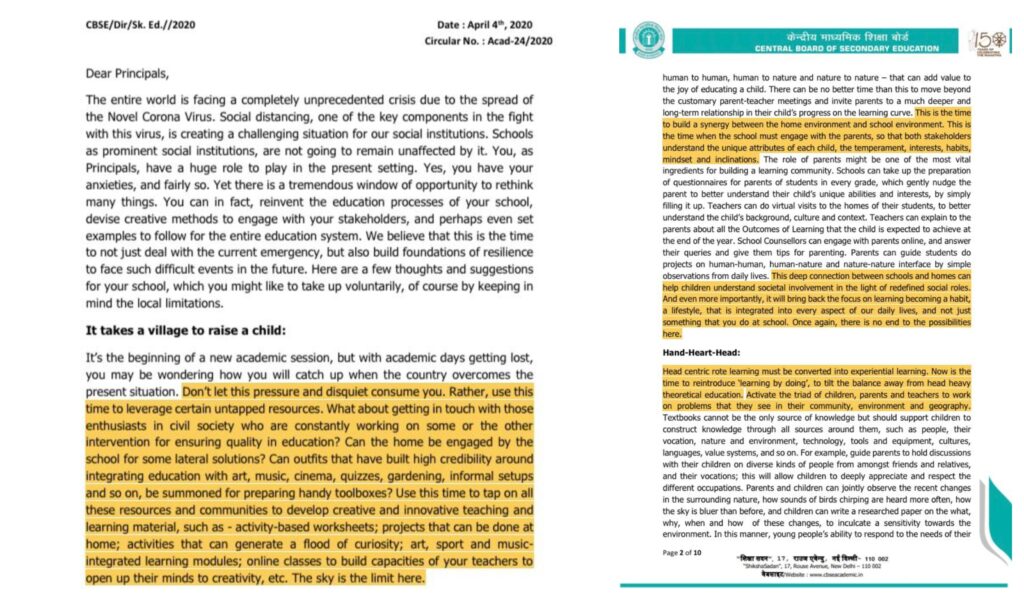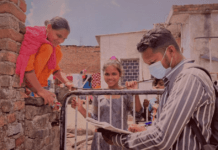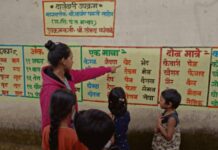In light of the national lockdown imposed to combat COVID-19, the CBSE has released a series of measures to be taken by students, teachers, and parents to continue at-home learning while schools remain closed.
The notifications contain a multitude of suggestions for students to take part in productive activities and to make the best use of their time during the lockdown. Statements from the authorities speak of the lockdown as an opportunity to implement experiential learning initiatives. They highlight the need to engage with life skills and values, rather than relying on rote learning and examinations. They further emphasise the importance and potential of collaboration between teachers, parents, and students to improve educational outcomes and growth.


Although these measures are welcome, they are overdue. Why has the CBSE waited until a global pandemic and national lockdown to address the necessity of collaboration and experiential learning, when avenues to pursue them have never before been so limited? In calling the lockdown ‘a golden opportunity for learning’ and ‘a boon’, is the CBSE taking into consideration the diversity in ability and access across students, schools, and households to cope with such circumstances? Will the CBSE continue with such efforts in a post-COVID-19 India to combat these shortcomings?
The State of the CBSE
The CBSE has clearly taken an optimistic outlook towards the lockdown. Yet, placing the onus of education on parents, teachers, and students themselves, most of whom are inexperienced and unequipped to navigate such unprecedented circumstances, reflects larger shortcomings towards educational reforms.
Apart from students, teachers can also leverage #NROER to access free e-resources around teacher education in just 1 click!
It is time to utilize your time at home to enhance your skills required to perform daily teaching tasks effectively in classrooms.https://t.co/MIjAOojMvL pic.twitter.com/1tbgi0zbFJ— Ministry of HRD (@HRDMinistry) April 16, 2020
The CBSE’s statements exalt the lockdown to be the necessary force for educational improvements in India. In doing so, the board deflects the existing shortcomings of the education system to the ‘opportunities’ presented by the lockdown. This disregards the fact that reforms are required irrespective of a global crisis, whether systemic, pedagogical, or infrastructural.
This deflection also highlights the inability of our education system to recognise the needs of students and teaching staff. Until now, the CBSE curriculum has focussed on textbook-centric, memorisation-based learning. Exams are evaluated based on ‘keywords’ from prescribed material, discouraging students from pursuing alternate resources. Furthermore, about 75% of all schools do not have proper lab funding for training or equipment. This means that teachers can neither deviate from the prescribed syllabus, nor can they make it hands-on even during a normal school day, let alone during a lockdown. Students may also find it challenging to be motivated to learn without their peers and teachers. It is likely that the systematic separation of education from personal life until now has left many students and parents unprepared to extend educational practice beyond the classroom environment.

In its statements, the CBSE also singularises the background of the students that it is reaching out to, trivialising the experiences of several others. Assumptions such as “Everyone has unlimited time, lab like home and all the resources of the world readily available on the Internet,” reinforce the CBSE’s lack of accountability in providing for students from diverse backgrounds.
The CBSE is affiliated with over 20,000 public and private schools with varying fee structures. This means that its curriculum is followed by students from diverse socio-economic backgrounds. Internet access, education levels of parents, and overall household priorities vary significantly among the students, which all affect their ability to be educated at home.
For example, according to the quarterly reports of the Telecom Regulatory Authority of India’s Performance Indicators, in 2017, only 28.77% of Indians have access to a continuous subscribed internet connection. Two thirds of these connections come from urban areas making the total number of internet connections per household uneven across the country. Furthermore, according to the Digital Empowerment Foundation, about 90% of the country’s population cannot navigate the internet and other technological resources effectively which could severely inhibit the success of e-learning initiatives. This ‘digital divide’ has only become even more evident amidst this ‘golden opportunity’ for education.
You May Also Like: The Education Budget 2020: More Money, Less Policy Execution?
Before the pandemic, e-learning was sidelined. Government schemes such as ‘Digital India’, meant to develop technological infrastructure and digital literacy in rural India, faced massive budget cuts leaving more than half of their targets unfulfilled. In 2019, the budget for e-learning was slashed down to 469 crores from 604 crores. Total spending on education itself has steadily declined since 2012, from 0.7% of the GDP, to 0.45% in 2020. The proportion of educational spending in the Union Budget has also decreased from 4.14% to 3.4% during this same period.
Looking Ahead
Under such circumstances, it is fair to say that the majority of students have not only been left unequipped but also neglected by the education system. The educational crisis that we are presently facing began long before the COVID-19 crisis ever set foot in the country. This time can be used to make amends for the better.
An essential step in this direction is Minister of Finance Nirmala Sitharaman’s announcement that educational channels will be broadcasted on television for each grade. 200 million households have a connection to cable television according to a 2018 Statista report. This will surely increase the number of students who can access at-home learning resources. Furthermore, efforts have been taken by the Ministry of Human Resource Development to partner with NCERT (National Council of Educational Research and Training) and NIOS (National Institute of Open Schooling) to distribute educational material to students through their schools. The CBSE’s encouragement of parent-teacher collaboration and learning through life skills, such as cooking is also a step in the right direction. In due course, reducing the cost of data packages and introducing training programs for students and teachers to use digital resources may be beneficial.
Govt has ensured that education of students does not suffer; #swayamprabha DTH channels are reaching those who do not have access to internet. The DIKSHA platform has seen 61 crore hits from 24th March onwards.#AatmaNirbharApnaBharat #AatmaNirbharBharatAbhiyan @MoHFW_INDIA pic.twitter.com/6qknvo98F3
— Dr Harsh Vardhan (@drharshvardhan) May 17, 2020
However, these efforts should not remain limited to the present circumstances. Education is and always has been a continuous process. Inequalities in educational resources in the present significantly deepen the inequalities in quality of life in the future. It is pertinent to bridge these gaps in a post-COVID-19 India. Specific localised efforts should be taken to make online education egalitarian, and in-class education oriented towards experiential learning. Most importantly, the board of education must hold itself to a standard greater than its teachers and students, such that crisis or not, students have access to an education centred around their growth as individuals equal to one another.
Featured image courtesy Melissa on Flickr (CC BY-SA 2.0)







[…] You May Also Like: Education in Times of COVID: Why Does It Take a National Lockdown to Revamp Our Education System? […]
Change is the need of system. We are sure the new education policy will revamp our education system and will help the students to gain more practical knowledge. Thank you for sharing this vital article.
Good thinking..
Well written article showcasing the ever widening gap in the society. It is true not just in the educational sector but in all other sectors. Changes need to happen in the policy level, but, if we do not know and acknowledge the gaps, how can policies change, right?
This is one such article, which brings about some awareness.
Spread the word.
Nice thought provoking article